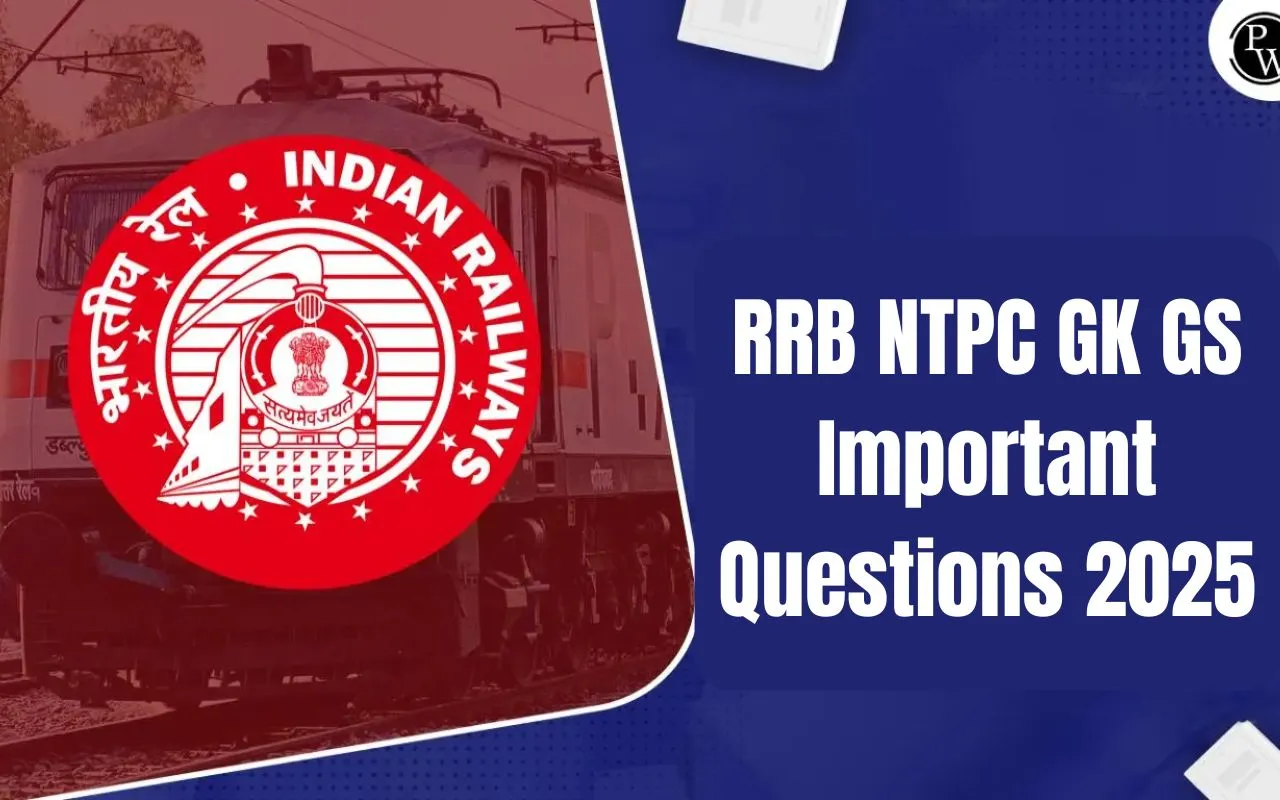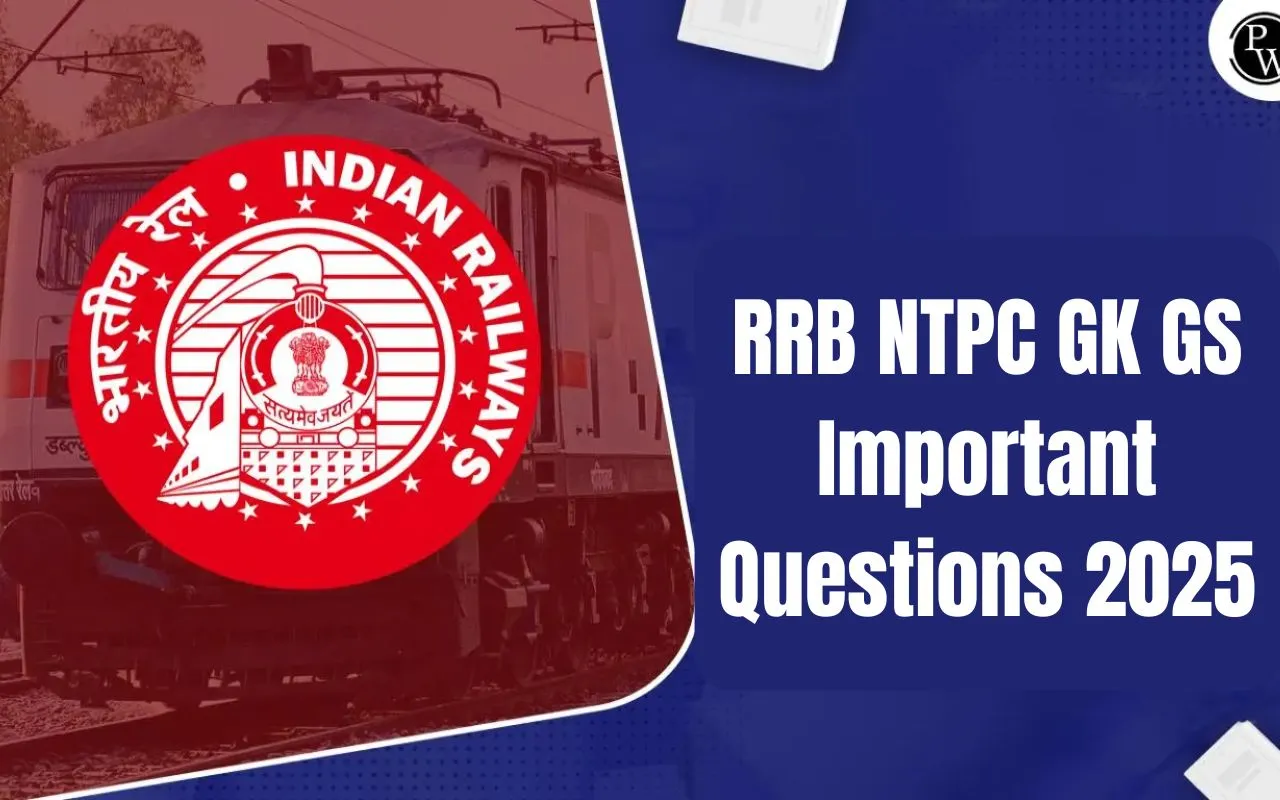

RRB NTPC GK GS 2025 help students get ready for the General Knowledge and General Science parts of the RRB NTPC exam. In these , students learn about history, geography, politics, science, and current news.
The NTPC GK GS Important Questions 2025 are very helpful for the exam. Many students find this part difficult because it has many topics to study. With proper and regular practice, students can learn better and feel more confident for the exam.
Overview of RRB NTPC GK GS 2025
Mentioned here are the RRB NTPC GK GS 2025 gist. Check the table below for more detailed information:
| Overview of RRB NTPC GK GS 2025 | |
| Feature | Details |
| Exam Name | RRB NTPC (Non-Technical Popular Categories) |
| Subject Focus | General Knowledge and General Science |
| Session Year | 2025 |
| Main Goal | To prepare students for GK & GS questions in the NTPC exam |
| Teaching Mode | Online and video lectures |
| Key Topics | History, Polity, Geography, Science, Current Affairs |
RRB NTPC GK GS Question Paper Pattern 2025
Understanding the paper pattern helps students plan better. The GK GS section of the RRB NTPC exam is designed to test knowledge accuracy and time management.
| RRB NTPC GK GS Question Paper Pattern 2025 | |||
| Section | Number of Questions | Marks | Question Type |
| General Awareness (GK & GS) | 40 | 40 | Objective (MCQ) |
| Mathematics | 30 | 30 | Objective (MCQ) |
| General Intelligence & Reasoning | 30 | 30 | Objective (MCQ) |
| Total | 100 | 100 | Objective (CBT) |
- Duration: 90 minutes
-
Negative Marking: 0.33 marks deducted for each wrong answer
-
Medium: English and regional languages
RRB NTPC GK GS Important Questions 2025 for Practice
Provided here are some of the important questions along with answers for aspirants to practice. Check the questions provided below and their explanation:
1. Why is sodium stored in kerosene?
Because sodium reacts quickly with air and water, so it is kept in kerosene for safety.
Explanation: Sodium is a very reactive metal. If it touches water or air, it catches fire. Kerosene stops air and water from reaching it.
2. Which gland produces tears in the human body?
Lacrimal gland.
Explanation: This gland is located near the eyes. It makes tears that keep our eyes clean and moist.
3. Naros or Nowruz festival is associated with which religion?
Parsi religion.
Explanation: Nowruz marks the Parsi New Year and celebrates spring and renewal.
4. The Jataka Tales are associated with which religion?
Buddhism.
Explanation: Jataka Tales tell stories about the previous lives of Gautam Buddha, teaching moral lessons.
5. Where did Gautam Buddha deliver his first sermon?
Sarnath.
Explanation: After attaining enlightenment, Buddha gave his first sermon at Sarnath near Varanasi.
6. What type of legislature does the Indian Parliament have?
Bicameral — Lok Sabha and Rajya Sabha.
Explanation: “Bicameral” means two houses. Lok Sabha is the lower house, and Rajya Sabha is the upper house.
7. Under which part and article of the Indian Constitution is the Parliament mentioned?
Part 5, Article 79.
Explanation: This article defines the structure and role of the Indian Parliament.
8. What are the three components of the Indian Parliament?
Lok Sabha, Rajya Sabha, and the President.
Explanation: These three together form the complete Parliament of India.
9. Minimum age required to become a Governor of a state?
35 years.
Explanation: The Constitution sets 35 years as the minimum age for the post of Governor.
10. Under which article is the Governor’s office mentioned?
Article 153, Part 6.
Explanation: This article talks about having a Governor for every state in India.
11. Who administers the oath to the Governor?
Chief Justice of the High Court.
Explanation: The Chief Justice ensures the Governor promises to follow the Constitution.
12. Who gives prior permission to introduce a Money Bill in the state legislature?
Governor.
Explanation: The Governor checks and approves before the Bill is introduced in the state.
13. Who gives prior permission to introduce a Money Bill in Parliament?
President.
Explanation: Only the President can allow the Money Bill to be introduced in the Lok Sabha.
14. In which house can Money Bills be introduced?
Lok Sabha (not in Rajya Sabha).
Explanation: Money Bills always start in Lok Sabha as per the Constitution.
15. What is the maximum time limit for a Money Bill in the Rajya Sabha?
14 days.
Explanation: Rajya Sabha can suggest changes within 14 days, but the final decision rests with Lok Sabha.
16. Name two South Indian film stars who entered politics.
Rajinikanth and Kamal Haasan.
Explanation: Both are famous actors from Tamil Nadu who later joined politics.
17. What is another name for black soil?
Regur soil.
Explanation: It is also called black cotton soil because cotton grows well in it.
18. Which crop grows well in black soil?
Cotton.
Explanation: Black soil holds moisture well, which helps cotton plants grow.
19. The “Silver Revolution” is related to which industry?
Sericulture (silk production).
Explanation: The Silver Revolution increased silk and egg production in India.
20. Which Constitutional Amendment introduced Panchayati Raj?
73rd Amendment, 1992 (effective 1993).
Explanation: This amendment gave constitutional status to local self-government in villages.
21. Which article mentions the Panchayati Raj system?
Article 40.
Explanation: Article 40 encourages states to organize village panchayats for local governance.
22. In which state and district was Panchayati Raj first implemented?
Rajasthan, Nagaur district (1959).
Explanation: Rajasthan started the Panchayati Raj system for rural development first in India.
23. Who was the Prime Minister when Panchayati Raj was first introduced?
Jawaharlal Nehru.
Explanation: He supported decentralization and launched the Panchayati Raj system.
24. What are “Mango Showers”?
Pre-monsoon rains that help mango ripening in Kerala and Karnataka.
Explanation: These light rains come just before the monsoon and help in early mango ripening.
25. Kerala is known as?
“God’s Own Country” and “Spice Garden of India.”
Explanation: Kerala has beautiful landscapes and grows many spices, earning these nicknames.
26. The Gosikhurd Irrigation Project is located in which state?
Maharashtra.
Explanation: It helps in irrigation and water storage for agriculture in Maharashtra.
27. The Gosikhurd Project is related to which river basin?
Godavari Basin.
Explanation: The dam is built on a tributary of the Godavari River.
28. How many odd days are there in a non-leap year?
1 odd day.
Explanation: A non-leap year has 365 days, which leaves 1 extra day over complete weeks.
29. When is World Environment Day celebrated?
June 5.
Explanation: It spreads awareness about protecting nature and the environment.
30. Which is the longest river in India?
River Ganga (2525 km).
Explanation: It flows across northern India and is sacred in Indian culture.
31. The “Save Narmada Movement” was against which dam project?
Sardar Sarovar Dam.
Explanation: People protested the dam due to displacement of local communities.
32. Who led the Save Narmada Movement?
Medha Patkar.
Explanation: She fought for the rights of people affected by the Sardar Sarovar Dam project.
33. When is Constitution Day celebrated in India?
November 26.
Explanation: It marks the day the Constitution was adopted in 1949.
34. When was the Constitution adopted and when did it come into effect?
Adopted: 26 November 1949; Effective: 26 January 1950.
Explanation: It came into force on Republic Day, making India a sovereign republic.
35. When is the Constitutional Emergency Day observed?
June 25 (marks 1975–77 emergency).
Explanation: This period saw suspension of many civil rights in India.
36. Who is known as the Father of the Indian Constitution?
Dr. B.R. Ambedkar.
Explanation: He was the main architect and chairman of the drafting committee.
37. Who is the Custodian of the Indian Constitution?
Supreme Court of India.
Explanation: The Supreme Court protects the Constitution and ensures justice.
38. Who wrote the book “Golden Threshold”?
Sarojini Naidu (1905).
Explanation: It is a collection of her poems expressing Indian culture and patriotism.
39. Who wrote “Discovery of India”?
Jawaharlal Nehru.
Explanation: Nehru wrote this book while in jail, describing India’s history and heritage.
40. Operation Flood is related to which sector?
Dairy (White Revolution).
Explanation: It made India the largest milk producer in the world.
41. Who is known as the Father of the White Revolution in India?
Dr. Verghese Kurien.
Explanation: He started Amul and improved milk production through cooperative movements.
42. When was ISRO established?
August 15, 1969.
Explanation: ISRO was created to develop space technology and satellites for India.
43. Who was the first Indian to win an individual Olympic gold medal?
Abhinav Bindra.
Explanation: He won gold in shooting at the 2008 Beijing Olympics.
44. Who designed the Olympic Rings and what do they represent?
Pierre de Coubertin; they represent five continents.
Explanation: The rings show unity among the five continents through sports.
45. When was the Planning Commission of India established?
1950.
Explanation: It planned the economic growth and development programs of India.
46. Which body replaced the Planning Commission?
NITI Aayog.
Explanation: NITI Aayog was created to promote cooperative federalism and new policies.
47. In which year was NITI Aayog formed?
2015.
Explanation: It replaced the Planning Commission to make faster and flexible economic plans.
48. How many Five-Year Plans were there in India?
12.
Explanation: The last Five-Year Plan (12th) ended in 2017.
49. What is the currency of Japan?
Yen.
Explanation: Yen is Japan’s official money used in all transactions.
50. Which Indian city is called the Silicon Valley of India?
Bengaluru.
Explanation: It is known for its large number of IT companies and startups.
51. Which Indian cricketer is mentioned in the video session?
Yuzvendra Chahal.
Explanation: He is a popular Indian spin bowler who plays in international matches.
PW provides Railway exam content, including Railway Exam Blogs, sample papers, mock tests, guidance sessions, and more. Also, enroll today on Railway Online Coaching for preparation.
